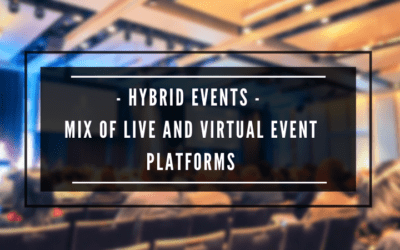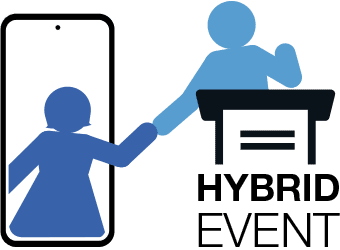The global pandemic and technological advancements have changed the way we hold meetings and host events. One of the most important lessons learnt by the events industry during covid-19 was that while virtual events certainly have their benefits, physical events will always be important because of human connections. Event planners are already considering the long-term impact of COVID-19 and how the future of events must adapt to how their attendees experience the world. As the world begins to open infinitesimally, hybrid events will dominate in 2022 and beyond. In fact, in a recent survey by Freeman Data Solutions, 78% of 20,491 brand marketers surveyed agree that moving forward, in-person events will pivot to hybrid models.
The new normal in the events industry will see hybrid events incorporating both live and virtual experiences. Hybrid events use cutting-edge technology to make the onsite event accessible virtually, with all of the opportunities, experiences, and benefits of the in-person event. With the hybrid model, participants can still attend in-person to network, make new connections, and generate potential leads. While as people who cannot or do not want to attend in-person can still experience and access the event using their computer, phone or tablet. Companies can reap the benefits of both in-person and virtual events with hybrid events.

HOW TO SET UP A HYBRID EVENT?
While event organizers new to the concept of hybrid events might worry that creating a hybrid event will double their workload or dilute the value of a longstanding onsite tradition, in reality, that is not the case. A hybrid event simply takes the onsite event and enhances it with a comprehensive virtual experience that extends the reach and value of your event. Virtual event platforms like FLOOR seamlessly connect onsite and virtual participants, providing a similar experience to each kind of attendee.
Here are the steps to host a hybrid event.
1. Consider Both Audiences Every Step of the Way
Planning a live event is one thing, but translating it well to the screen is another. Hosting an exceptional hybrid event requires mastering both of these tasks. When planning your event, keep both audiences in mind. Find ways to captivate your in-person attendees, while using additional strategies to keep your virtual audiences engaged too.

It takes a lot of effort to plan and execute a hybrid event, and you’re the designer of this event. You’re responsible for designing an agenda that caters to both in-person and virtual attendees, and it is up to you to develop a compelling and useful program. Below are some key questions to ask yourself as you produce your hybrid event agenda:
How long will your sessions run?
Will your sessions be an hour? A half-hour? 15 minutes? A variety of lengths? You should strike a balance between the length of your sessions and the amount of information you can share. However, they should also be concise enough that virtual attendees can remain focused and engaged.
How many sessions will you host per day?
It’s important not to overwhelm people with information and content. As onsite attendees travelled a great distance to attend, they will most likely want to attend more sessions. While your virtual attendees are likely to have a shorter attention span being seated in front of a computer screen. Part of the solution is to offer fewer live sessions per day for your virtual attendees. Instead, offer more on-demand content that they can access at their leisure.
Will you have different sessions for virtual versus in-person attendees?
Is there going to be a session that’s only available to in-person attendees and a session that’s only available to virtual attendees? How about hosting an in-person networking event that virtual attendees won’t be able to attend? What will you offer those virtual attendees instead? Identify how your registration paths will differ for different attendees.
2. Work With Venues and Gather the Necessary Equipment
Hybrid events require a strong partnership with the venue hosting the in-person meeting. This means not only providing high-speed internet access and having an on-site A/V team to deal with technical issues, but also optimizing the design of breakout rooms, rooms, and technology tools to optimize production for remote attendees.
Next, you need to gather the right equipment. Your choice of event technology has a major impact on your remote audiences.
Here are some key items you’ll need:
- Cameras – High-definition cameras are essential to hybrid events. By positioning them in strategic locations around the venue, you can provide virtual viewers with a more immersive experience. With tripods and risers, you can ensure that your footage is smooth, steady, and stable. Last but not least, make sure you invest in professional lighting for your venue and speakers.
- Microphones – Today’s audiences are less tolerant of poor audio quality. Make sure your presenters are mixed up with studio-quality equipment, so they can be heard clearly in the venue and online. It is also necessary to have a sound specialist on-site to adjust volume levels and sound quality in real-time.
- A virtual live-streaming platform – You can live stream your event on a wide range of platforms, however, not all of them are built the same way. Make sure to choose a reliable and easy-to-use live-streaming platform. Virtual platforms with built-in communication features, like polling and real-time chat, provide more engagement and networking opportunities.
- Servers – The last thing that you need to do is invest in a server that can record and store event footage. With this, you can use the footage for future marketing campaigns.
3. Hire Your Staff
You need an experienced team on your side to pull off a successful hybrid event.
Here are some virtual event professionals you’ll need to hire:
- A virtual event manager
- Cameramen
- Sound engineers
- Video specialists
- A/V tech specialists
- Server specialists
- On-call technical support staff
- Social media moderators
- A virtual emcee
Putting together such a team can be a daunting task. Consider outsourcing the event management process to make life easier for yourself. They’ll provide a crew of qualified virtual event experts who will put on a flawless show.
4. Prepare Pre-Recorded Content
Keeping your virtual attendees interested is a challenge for hybrid events. To fill the time between live sessions, you’ll need some virtual-only content prepared, such as
- A pre-recorded video snippet to roll out during intermissions
- A downloadable infographic (which you can post on your virtual platform)
- A downloadable agenda so virtual attendees can see what’s coming next
- Be sure to upload this material before your event. Therefore, you will be able to download it yourself and check that it renders correctly.

5. Hire a Charismatic Virtual Emcee
Virtual emcees serve as facilitators for virtual attendees. They should be charismatic and entertaining, as their job is to keep your audience engaged.
During breaks in the live event, your emcee will prompt online participants to
- Submit their questions for the Q&A
- Participate in a poll
- Share their thoughts on social media
- Post online with a custom hashtag
- Refer to a downloadable file on the virtual platform
You can enhance your remote audience’s experience by investing in a virtual emcee. They’ll feel as if their attendance is valued. Furthermore, you can use their feedback and comments later on to assess the success of your event.
6. Set up Event Mobile App
In order to deliver a seamless event experience, you must use an event mobile app. This app allows you to connect the attendees in virtual and in-person sessions to form a large community for more networking opportunities. It allows attendees to share experiences, their thoughts, images, and videos. You can allow attendees to create profiles to display their location, photos, interests, and bios. This enables individuals with similar interests to connect.
By allowing polls, questions, and vital data collection, you can measure attendee engagement, satisfaction, and ROI (Return on Investment).
You can provide event attendees with a personalized experience through the use of an event mobile app. Before the event, you can send attendees venue maps, schedules, exhibitor information, speaker bios, and more. You can also add a feature that allows attendees to take notes in the app and then download them after the event.

7. Test Your Event
Run a test of your event to check your camera angles, lighting, and sound. This way, you can be confident on the day of your event. During this time, your presenters can also practice their talking points and get comfortable on stage. Encourage speakers to address both in-person and remote audiences. It’s easy to overlook online participants, but they crave acknowledgement too.
The past few months have been anything but predictable. A major lesson we learned during this pandemic is the importance of being prepared. A hybrid event model is one of the most effective ways for companies to protect their time, money, and resources when planning a future event. FLOOR is an award-winning virtual and hybrid event platform that allows you to combine the best of in-person and virtual events to provide your audience with immersive and memorable event experiences.




0 Comments